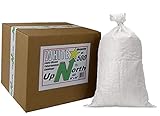All Categories









Sandbaggy Black Sandbags - Empty Poly Bags W/ 4000 HR UV Protection - 14 Inch x 26 Inch - Ultra-Tough Sand Bags That Can Be Dropped 40 Times (300 Bags)
Share Tweet








About Sandbaggy Black Sandbags - Empty Poly Bags W/ 4000
Heavy duty, with UV protection: Our rugged Sandbaggy sandbags are made with thick weaves allowing for heavy-duty applications like sandbagging, landscaping, construction, and building flood barriers. The weave count is 10x10. Our tough, coarsely-woven sandbags can be used for so many different applications. Made with 4000 hours of UV protection, these sandbags can sit under the sun for nine months before they begin to degrade. Sandbags Filling Tips: 1. Fill sandbags ½ to ⅔ full and tie the bag at the top (lay flat when in place). This sandbag should weigh between 35-40 lbs. An overfilled sandbag weighs between 60-75 lbs and will leave gaps which will allow water to seep through. 2. Always wear gloves during filling operation to avoid hand injuries and protect from contaminants in sand and floodwater. Safety goggles should be used on dry and windy days. Filling sandbags is physically demanding work and can easily cause back and other injuries if not careful. Always lift with your legs and not your back. Do not reach out, bend over, or twist when lifting. 3. Do not throw sandbags - it stresses the back and shoulders. Rather use a brigade line to pass bags 4. Use a short handled, #2 rounded point shovel with straight shaft and D grip, bagger scoop or funnel to fill sandbags. 5. Remove any debris from the areas where the sandbags will be placed. After placing the sandbag, walk on sandbags to create a tight seal between each bag. Fill Materials - Sandbaggy sandbags are built to withstand both gravel or sand. Be aware of poor quality sandbags that rupture when filled with sharp gravel rocks. - Gravel should be filled in sandbag when used as an erosion control device (on slopes). Sand should be filled for flood control needs, whether to protect doors or garage or to divert water. If sand or gravel is not accessible, less effective solutions is to fill the sandbags with backyard soil.





















